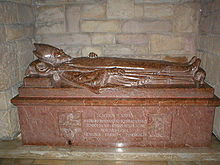Plazidus bird
Plazidus II. Vogel OSB (born April 24, 1871 in Rehau (Monheim) ; † May 18, 1943 in Lülsfeld ) was the 71st abbot of the Münsterschwarzach Abbey and the 1st abbot of the rebuilt abbey after secularization .
Life
Plazidus Vogel (Christian name Hans Georg) was born on April 24th, 1871 in Rehau . In 1887 he went to Sankt Ottilien to attend the local high school. In 1890 he entered the novitiate there and made his vows on August 15, 1891. Vogel studied theology in Dillingen an der Donau and was ordained a priest on July 25, 1895. After his ordination, Vogel taught at the Ottilian grammar school, which he later headed as rector.
In 1901, those in charge of the St. Ottilien Abbey appointed Plazidus Vogel to lead the re-establishment in St. Ludwig in Lower Franconia , a former spa in the district of Wipfeld . In 1911 and 1912 Vogel accompanied the Ottilian abbot Norbert Weber on his travels to Korea and East Africa . There he got to know the mission areas of the congregation at that time.
Due to the rapidly growing community, the buildings and the expansion options in St. Ludwig soon reached their limits. That is why in 1913 the company moved to the Münsterschwarzach monastery, which had been abandoned since 1803 .
On April 1, 1914, Münsterschwarzach was elevated to the status of an abbey , and Norbert Weber, the abbot of St. Ottilien, appointed Plazidus Vogel as the first abbot of the rebuilt abbey. He was the second abbot of Münsterschwarzach with the name Plazidus. The abbot was granted on April 14, 1914 by Ferdinand von Schlör , Bishop of Würzburg. His motto was: plus amari quam timeri (“More to be loved than to be feared”), a quote from the Benedictine Rule about the role of the abbot. The culmination of his life's work was the construction of the new Münsterschwarzach abbey church, which was inaugurated in December 1936.
On February 25, 1937, Plazidus Vogel resigned due to illness. As a justification he said: “I do not want to let go of what I have laboriously built up in my manhood because of the weakness of my age.” On March 11, 1937, Burkhard Utz was elected as his successor . 1959 to 1982 Vogel's nephew Plazidus was Abbot Bonifaz von Münsterschwarzach.
When the National Socialists closed the abbey in 1941, Plazidus Vogel went into exile in Lülsfeld , to a community of Oberzell Franciscan Sisters ("Redeemer Sisters") , where he also died on May 18, 1943. He found his final resting place in 1947 in the abbey church of Münsterschwarzach.
literature
- Paulus Weißenberger: Abbot Plazidus Vogel and the beginnings of the Benedictine Congregation of St. Ottilien . In: Studia Suarzacensia , Würzburger Diözesangeschichtsblätter 25, 1963, pp. 253-308.
- Rainer Kengel: The history of the resurrected abbey from 1913–1938 . In: Münsterschwarzach - Heut und Einst , Missionsverlag Münsterschwarzach, 1938, pp. 31–35.
- Gabi Gess: Abbot of Münsterschwarzach. In: Church newspaper for the diocese of Eichstätt, No. 13 of March 30, 2014, p. 15.
- Johannes Mahr: Father Plazidus Vogel OSB and Father Basilius Konrad OSB . In: Franziskus Büll (ed.): Magna Gratulatio. 1200 years of Benedictine monastic community from Münsterschwarzach 816–2016 . Vier-Türme-Verlag, Münsterschwarzach 2016, ISBN 978-3-89680-899-8 , pp. 275-296.
| predecessor | Office | successor |
|---|---|---|
| ( Judas Thaddäus Sigerst ) |
Abbot of Münsterschwarzach 1914–1937 |
Burkhard Utz |
| personal data | |
|---|---|
| SURNAME | Bird, placidus |
| ALTERNATIVE NAMES | Vogel, Georg (maiden name); Bird, placidus |
| BRIEF DESCRIPTION | German chaplain, abbot of Münsterschwarzach |
| DATE OF BIRTH | April 24, 1871 |
| PLACE OF BIRTH | Rehau |
| DATE OF DEATH | May 18, 1943 |
| Place of death | Lülsfeld |


